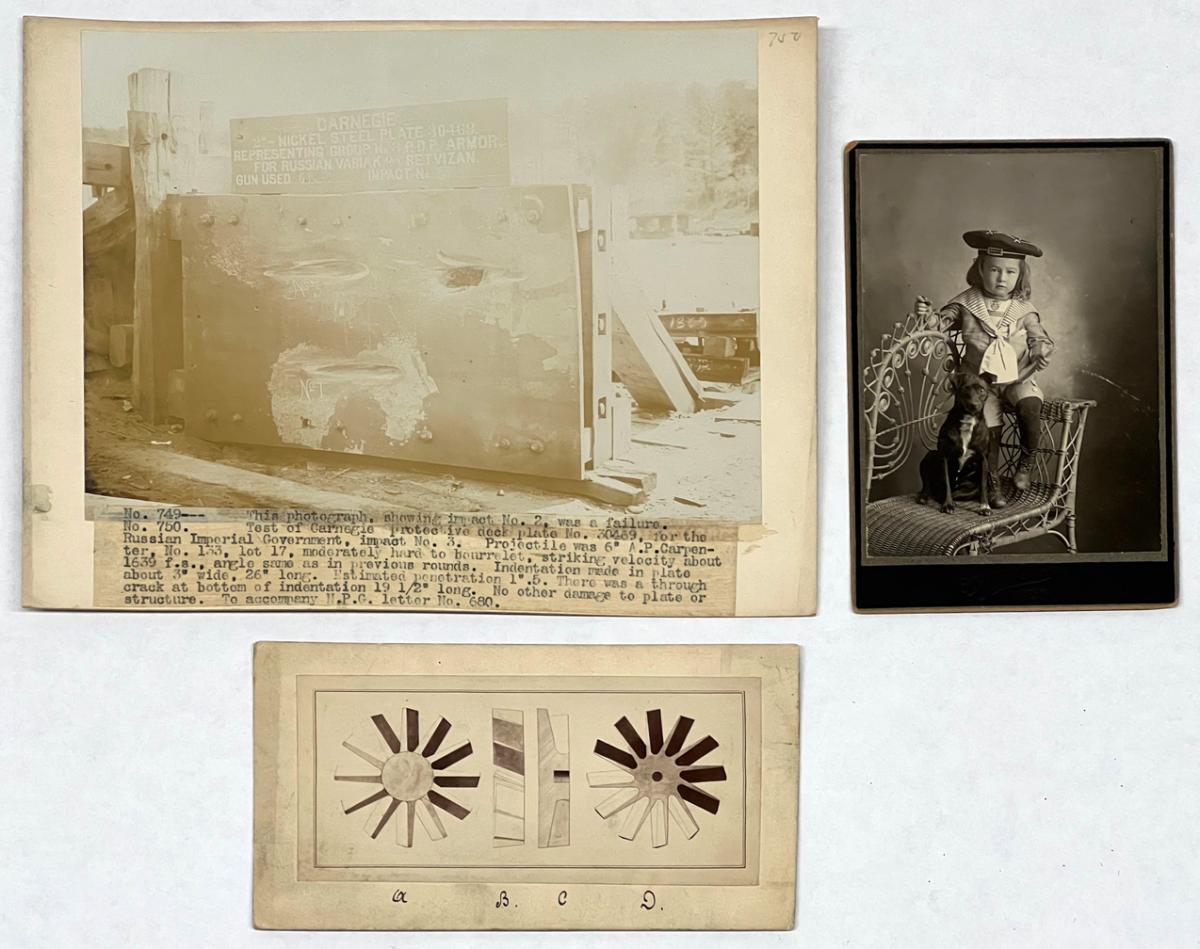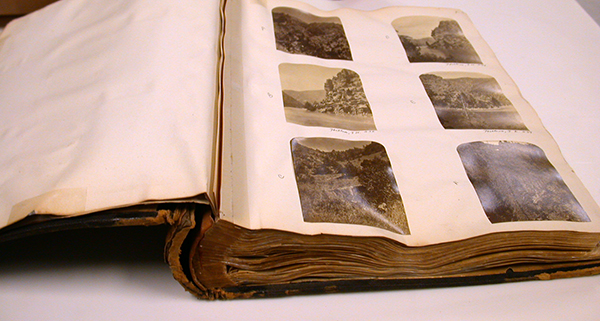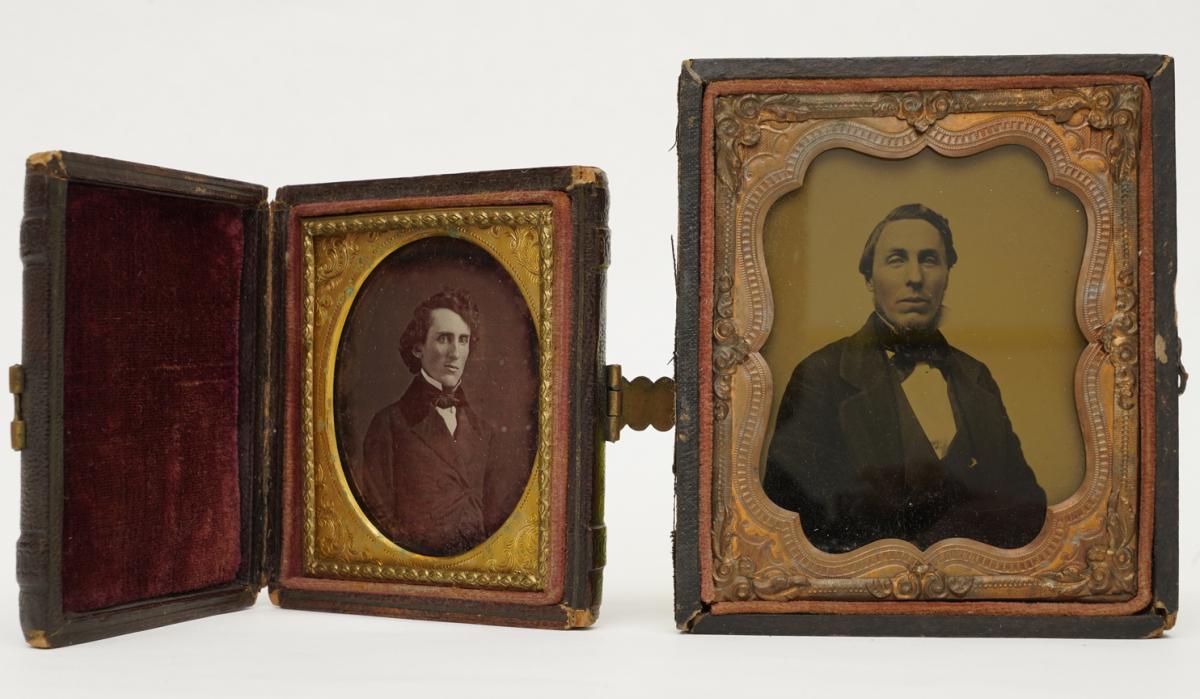
Photographs
Ever since the first true photograph was made in 1827, a wide variety of processes and supports have been used to create photographic images. In North America, the first photographs produced were daguerreotypes beginning in 1839. Among the more common photographic processes that are found in NARA holdings are daguerreotypes, ambrotypes, tintypes, salted paper prints, albumen prints, glossy and matte collodion prints, cyanotypes, platinum prints, silver gelatin printed-out paper prints, silver gelatin developed-out paper prints, chromogenic color prints, polaroids, inkjet prints, lantern slides, glass plate negatives, and film-based negatives, transparencies and slides. The photographic holdings of NARA’s Still Picture Branch alone include over 14 million analog prints, negatives, slides and transparencies and over three million digital photographs in electronic file formats.
The following are general guidelines for preservation of photographs. Additional preservation guidelines for film-based negatives and positives can be found on our website.
- Handling Photographs
- Using Enclosures for Photographs
- Damaged Photographs
- Three-Dimensional Photographic Formats
Handling Photographs
To the extent possible, clean nitrile or cotton gloves should be worn when handling photographs. Oils, salts, and other skin deposits can degrade the image over time. Handle each photograph by its edges and avoid touching the image area even when wearing gloves. Many photographic emulsions and digital prints can be easily scratched, cracked, or dented.
- Support a photograph with two hands and avoid bending or curling the record. Never fold or roll a photograph. Many photographs have a slight natural curl; do not back roll a photograph in an attempt to flatten it.
- If there is visible dust or debris on a photograph that might scratch the image, brush it lightly with a clean, soft brush. A hand operated puff-style blower can also be used to reduce dust on photographic records. Canned air should be avoided due to the force of the air stream and potentially damaging propellants.
- When dusting, always support the photograph by gently holding it on a flat surface. Brush or blow at an angle working from one corner or edge across the item.
- Do not dust a torn photograph, one with cracked or lifting emulsion, or one that is highly significant. Consult a photograph conservator for further guidance.
Remove paper clips, staples, fasteners, rubber bands, and Post-It® Notes used to label or organize photographs; these can damage the emulsion image. Instead, use folders, subfolders, paper tabs or envelopes to maintain associations.
Do not try to remove photographs from mounts, backings, or similar supports or separate a photograph adhered to an album page. Doing so may damage the emulsion or tear the photograph.
Whenever possible, identify a photograph on its storage enclosure.
- Write on the enclosure before placing the photograph inside; do not write on an enclosure with a photograph inside.
- When necessary, use a No. 2 pencil or softer to write notations only on the reverse edge of a paper print. Avoid writing in the image area or elsewhere on the front of the photograph. Make notations only along the edge.
- On coated surfaces, like resin-coated (RC) paper, use a pen that is waterproof, resistant to fading, non-acidic, and meets Art and Creative Materials Institute (ACMI) non-toxicity standards Approved Product (AP) Seal; preservation supply companies have these pens.
Many photographic processes are very sensitive to pollutants, making it especially important to use enclosures and housing materials that are lignin free, acid free, and either buffered with an alkaline reserve or of neutral pH.
Enclosures for Photographs
Use products that conform to specifications:
| NARA Specifications | OR |
ISO 18902: Imaging materials - Processed imaging materials - Albums, framing and storage materials ISO 18916: Imaging materials - Processed imaging materials - Photographic activity test for enclosure materials |
Some photographic processes like cyanotypes and blueprints are sensitive to the higher alkaline pH found in buffered storage materials. For these records, use pH neutral, unbuffered housing materials.
Photographs interspersed with other archival records can be retained in the appropriate folder or other enclosure with the associated records. A photograph does not necessarily need to be sleeved, placed in an enclosure, or relocated for storage.
Sleeving can protect a fragile photograph and allows the photograph to be handled along with other records without the need to stop and put on gloves. Sleeves can be costly, however, and add bulk to the storage container. Consider sleeving:
- For use: Significant photographs and photographs in very heavily used collections.
- When interspersed: A smaller photograph interspersed among other archival records that may slip out when a folder is handled.
- When damaged: A photograph with extensive tears that make handling difficult without causing damage to the image. A sheet of archival bond paper placed underneath may provide enough support to handle the photograph safely without sleeving.
- When required for a housing project: An entire collection of photographs or a large grouping of photographs may be housed in individual polyester sleeves or paper envelopes. Ask the project supervisor if sleeving all photographs is part of the holdings maintenance project.
If a photograph will be sleeved or placed in an envelope use clear inert plastic sleeves or opaque paper enclosures.
Clear inert plastic enclosures made of polyester, polypropylene, and polyethylene can be used in a stable, moderate environment. Opaque paper sleeves and enclosures that meet the archival standards and pass the PAT (Photographic Activity Test) are also available. Do not use office quality paper, kraft paper, plastics containing PVC, or glassine enclosures.
- For an active archive, uncoated polyester film envelopes and sleeves are generally preferable to paper because the image can be seen without removing it from its enclosure.
- Photographs can be digitized through the polyester sleeve using an overhead camera set up or on a flatbed scanner if handled with extra care. Use an overhead set up with any photograph that has extensive damage or is heavily curled.
- Paper envelopes are less expensive, protect the item from light exposure, buffer against pollutants and humidity, and are easy to label with a No. 2 pencil. They do increase handling since the item must be removed from the enclosure for viewing.
- When using a paper enclosure, position the emulsion side away from any seams to prevent potential exposure of the image to the adhesive.
Remove paper clips, fasteners, rubber bands, and Post-It® Notes used to label or organize photographs before placing a photograph in a sleeve or enclosure.
It is best to only house one photograph in a sleeve or envelope. If two photographs must be stored in one sleeve or envelope, they should be stored back-to-back.
If an existing enclosure has identifying information, determine how to duplicate the information or consider keeping the current enclosure as part of the rehousing exercise. To do this, evaluate the quality of existing sleeves and enclosures. Consider replacing a sleeve with an archival enclosure if it is brittle, torn, warping, or otherwise of obvious poor quality and causing damage to the photograph.
Damaged Photographs
It is preferable to use a polyester L-sleeve enclosure configuration for housing most torn photographs. Other configurations of plastic sleeves or paper enclosures may be appropriate to use depending on the level of damage and specific type of photograph or housing project. Contact a photograph conservator or preservation specialist for additional guidance.
Use a polyester L-sleeve or a paper folder or subfolder to house a photograph with limited emulsion damage, such as minor flaking along the edges. Even though a polyester sleeve can generate static electricity that has the potential to displace flaking pieces, it is still often the best option, especially if the photograph will be digitally imaged.
- As with paper records, use a sheet of archival bond paper, cardstock or board to support a damaged photograph as you place it into the sleeve. The paper can be slipped out after positioning the photograph or left in place if there is no information on the reverse.
- To provide additional support, place a sleeved and badly damaged photograph in a paper folder.
- Depending on the extent of damage and available resources, use a paper folder, subfolder, four-flap enclosure or window mat to protect a photograph with more significant flaking or lifting emulsion. Store the photograph horizontally, if possible.
- For a highly significant print, consider using a window mat and storing it flat to avoid any contact with the image.
- Discuss the best storage method for a photograph with significant lifting and flaking of the emulsion with a photograph conservator.
Photographs may be stored on edge in a box if they are smaller than 8 ½” x 11”. A letter or legal sized storage box can be used for vertical storage of photographs smaller than the box. Use a spacer board or filler board if needed to hold the photographs upright and prevent bending or curling that can damage the emulsion.
Large photographs (over 8 ½” x 14”), may be stored flat (horizontal) in boxes. Boxes with detached lids or clamshell-style boxes are preferable for housing oversize photographs.
- When multiple sizes are stored in the same box, group photographs by size whenever possible and arrange so that smaller photographs are on top of larger ones.
- Avoid overfilling boxes
- Very heavy boxes should not be stacked. Avoid stacking flat boxes more than two high.
Storage in temperatures at or below 35°F, referred to as cold storage, is recommended for color photographs that are highly significant.
Even low levels of ozone can degrade the quality of many photographic images. Store them away from ionizing air cleaners and other sources of ozone. If significant photographs are stored in highly polluted environments, discuss using boxes or enclosures with molecular traps (zeolites) or activated charcoal with a photograph conservator.
Three-Dimensional Photographic Formats
Daguerreotypes, Ambrotypes, Tintypes, Glass (Lantern) Slides, Glass Negatives and Others
Three-dimensional formats require careful storage to protect them and prevent damage to adjacent records.
- Store each item in an individual enclosure; paper enclosures such as envelopes and four-flap enclosures are generally preferred for cased photographs and negatives.
- To prevent abrasion, consider storing an uncased tintype in a plastic sleeve so it can be viewed without removing from the enclosure. If an uncased tintype has lifting or flaking emulsion, it may be preferable to store it in a four-flap paper enclosure or folder.
- To maximize space, most three-dimensional photographs can be stored vertically or horizontally, if they are in good condition. It is recommended to store glass plate negatives and glass lantern slides vertically unless they are broken.
- If space allows, cased photographs that are mixed in with textual records can be stored in the protective cavity created by a folded spacer board in the back (or front) of the box.
- Be aware of the accumulated weight when housing multiple cased photographs, lantern slides, or glass negatives in a box. Accumulated weight can make a box unsafe to handle, potentially causing damage to the contents.
- Avoid stacking very heavy boxes and those containing glass negatives and other breakable formats.
- Discuss options for broken and damaged cased photographs and glass plate negatives or slides with a photograph conservator.


